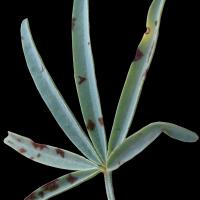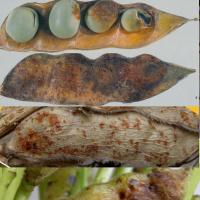Diagnosing brown spot in narrow-leafed lupins
Brown spot (Pleiochaeta setosa ) is the most widespread foliar disease of lupins in Western Australia (WA). All lupin species are affected although yellow lupins show resistance. The same fungus causes Pleiochaeta root rot.
What to look for
- Plants with dark brown lesions on leaves that are prematurely shed, with oldest leaves affected first.
- Symptoms are worst where soil and spores are more easily splashed on to the plant. These include heavy or waterlogged soils, or where the soil is not protected by stubble, gravel or dense lupin growth.
Paddock
- Infected cotyledons develop dark brown spots, become chlorotic and shed prematurely.
- Leaves develop dark brown spots that are often net-like in appearance and can be distorted and smaller before being shed prematurely. Petioles and stems can also be affected.
- Severe brown spot symptoms cause stunting of seedlings with associated defoliation and distortion of leaves
- On adult plant stems, brown flecks may be evident, occasionally developing into large brown-black cankers that kill the stem above the infection point, and may cause the stem to snap.
- Pods, particularly those set closer to the ground, may be flecked or develop larger brown lesions.
Plant
What else could it be
| Condition | Similarities | Differences |
|---|---|---|
| Diagnosing grey leaf spot in broadleafed crops | Dark spots on leaflets | Rare. Brown spot lesions are dark brown often net-like rather than circular grey spots |
| Diagnosing cladosporium leaf spot in narrow-leafed lupins | Dark spots on leaflets | Rare. Brown spot lesions are dark brown often net-like rather than circular grey spots |
Where did it come from?

Contaminated soil
- Paddocks which have previously grown lupins will have pleiochaeta spores in the soil. The disease can infect lupins at all stages of growth but seedling infection has the greatest impact on yield.
- Spores produced on dead tissue become incorporated into the surface layers of the soil where they can persist for several years, although under non-host crops the concentration reduces over time.
- Infection occurs when spores are splashed by rain from the soil onto new lupin plants.
- Factors which reduce the growth rate of plants include colder environments, late sowing, poor nutrition, herbicide damage or unfavourable soil type, and prolonged exposure to rain-splash at the most susceptible seedling stage.
Management strategies

Rotation

Seed dressing fungicide
- Soil borne spore concentration diminishes under non-host crops; consequently longer rotations reduce risk of brown spot infection.
- Sowing lupin into retained cereal stubble reduces rain splash of soil-borne spores onto foliage.
- Application of iprodione or procymidone based seed dressing fungicides dramatically reduces seedling brown spot infection.
- Factors which promote seedling vigour and canopy closure include early sowing, adequate nutrition, care in herbicide use, higher seeding rates and sowing onto favourable soils to reduce disease impact.
- Small differences in brown spot tolerance exist between narrow-leafed lupin varieties but this does not remove requirement for other management approaches.
- Foliar sprays are ineffective.
See also
Where to go for expert help
Page last updated: Thursday, 16 April 2015 - 4:26pm





